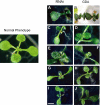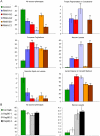Phenotypic diversity and altered environmental plasticity in Arabidopsis thaliana with reduced Hsp90 levels
- PMID: 17653275
- PMCID: PMC1920555
- DOI: 10.1371/journal.pone.0000648
Phenotypic diversity and altered environmental plasticity in Arabidopsis thaliana with reduced Hsp90 levels
Abstract
The molecular chaperone HSP90 aids the maturation of a diverse but select set of metastable protein clients, many of which are key to a variety of signal transduction pathways. HSP90 function has been best investigated in animal and fungal systems, where inhibition of the chaperone has exceptionally diverse effects, ranging from reversing oncogenic transformation to preventing the acquisition of drug resistance. Inhibition of HSP90 in the model plant Arabidopsis thaliana uncovers novel morphologies dependent on normally cryptic genetic variation and increases stochastic variation inherent to developmental processes. The biochemical activity of HSP90 is strictly conserved between animals and plants. However, the substrates and pathways dependent on HSP90 in plants are poorly understood. Progress has been impeded by the necessity of reliance on light-sensitive HSP90 inhibitors due to redundancy in the A. thaliana HSP90 gene family. Here we present phenotypic and genome-wide expression analyses of A. thaliana with constitutively reduced HSP90 levels achieved by RNAi targeting. HSP90 reduction affects a variety of quantitative life-history traits, including flowering time and total seed set, increases morphological diversity, and decreases the developmental stability of repeated characters. Several morphologies are synergistically affected by HSP90 and growth temperature. Genome-wide expression analyses also suggest a central role for HSP90 in the genesis and maintenance of plastic responses. The expression results are substantiated by examination of the response of HSP90-reduced plants to attack by caterpillars of the generalist herbivore Trichoplusia ni. HSP90 reduction potentiates a more robust herbivore defense response. In sum, we propose that HSP90 exerts global effects on the environmental responsiveness of plants to many different stimuli. The comprehensive set of HSP90-reduced lines described here is a vital instrument to further examine the role of HSP90 as a central interface between organism, development, and environment.
Conflict of interest statement
Figures








Similar articles
-
Hsp90 as a capacitor of phenotypic variation.Nature. 2002 Jun 6;417(6889):618-24. doi: 10.1038/nature749. Epub 2002 May 12. Nature. 2002. PMID: 12050657
-
HSP90-buffered genetic variation is common in Arabidopsis thaliana.Proc Natl Acad Sci U S A. 2008 Feb 26;105(8):2969-74. doi: 10.1073/pnas.0712210105. Epub 2008 Feb 19. Proc Natl Acad Sci U S A. 2008. PMID: 18287064 Free PMC article.
-
A protective role of HSP90 chaperone in gamma-irradiated Arabidopsis thaliana seeds.Life Sci Space Res (Amst). 2015 Jul;6:51-8. doi: 10.1016/j.lssr.2015.07.002. Epub 2015 Jul 9. Life Sci Space Res (Amst). 2015. PMID: 26256628
-
The HSP90 chaperone complex, an emerging force in plant development and phenotypic plasticity.Curr Opin Plant Biol. 2005 Feb;8(1):86-92. doi: 10.1016/j.pbi.2004.11.012. Curr Opin Plant Biol. 2005. PMID: 15653405 Review.
-
It's not magic - Hsp90 and its effects on genetic and epigenetic variation.Semin Cell Dev Biol. 2019 Apr;88:21-35. doi: 10.1016/j.semcdb.2018.05.015. Epub 2018 Jun 6. Semin Cell Dev Biol. 2019. PMID: 29807130 Free PMC article. Review.
Cited by
-
Transcriptome analysis of cytoplasmic male sterility and restoration in CMS-D8 cotton.Plant Cell Rep. 2013 Oct;32(10):1531-42. doi: 10.1007/s00299-013-1465-7. Epub 2013 Jun 7. Plant Cell Rep. 2013. PMID: 23743655
-
Jasmonate signalling in Arabidopsis involves SGT1b-HSP70-HSP90 chaperone complexes.Nat Plants. 2015;1:15049. doi: 10.1038/nplants.2015.49. Epub 2015 Apr 27. Nat Plants. 2015. PMID: 27054042 Free PMC article.
-
Inhibition of Heat Shock proteins HSP90 and HSP70 induce oxidative stress, suppressing cotton fiber development.Sci Rep. 2018 Feb 26;8(1):3620. doi: 10.1038/s41598-018-21866-0. Sci Rep. 2018. PMID: 29483524 Free PMC article.
-
HSP90 Contributes to Entrainment of the Arabidopsis Circadian Clock via the Morning Loop.Genetics. 2018 Dec;210(4):1383-1390. doi: 10.1534/genetics.118.301586. Epub 2018 Oct 18. Genetics. 2018. PMID: 30337341 Free PMC article.
-
Small chloroplast-targeted DnaJ proteins are involved in optimization of photosynthetic reactions in Arabidopsis thaliana.BMC Plant Biol. 2010 Mar 7;10:43. doi: 10.1186/1471-2229-10-43. BMC Plant Biol. 2010. PMID: 20205940 Free PMC article.
References
-
- Wegele H, Muller L, Buchner J. Hsp70 and Hsp90–a relay team for protein folding. Rev Physiol Biochem Pharmacol. 2004;151:1–44. - PubMed
-
- Whitesell L, Lindquist SL. HSP90 and the chaperoning of cancer. Nat Rev Cancer. 2005;5:761–772. - PubMed
-
- Queitsch C, Sangster TA, Lindquist S. Hsp90 as a capacitor of phenotypic variation. Nature. 2002;417:618–624. - PubMed
Publication types
MeSH terms
Substances
Grants and funding
LinkOut - more resources
Full Text Sources
Other Literature Sources
Molecular Biology Databases

